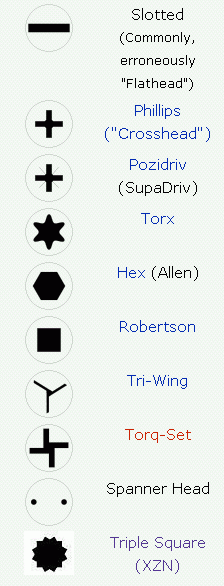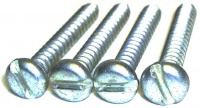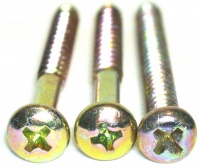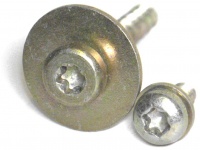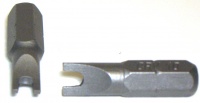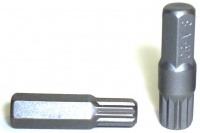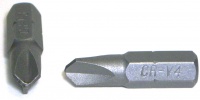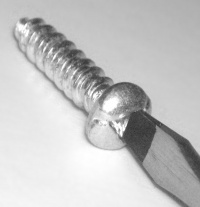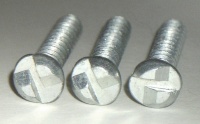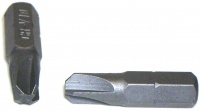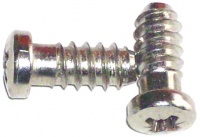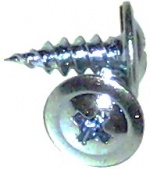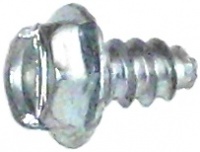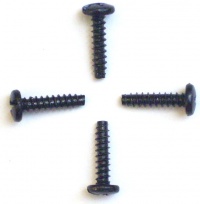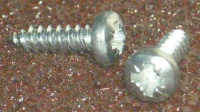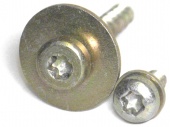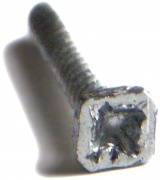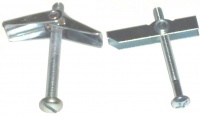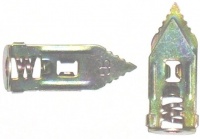Difference between revisions of "Screws"
(→Torx: pic) |
|||
| (25 intermediate revisions by 2 users not shown) | |||
| Line 1: | Line 1: | ||
| − | + | [[image:Net coat coach bolt 5490-2.jpg|right|350px]] | |
| − | + | Using '''screws''' is simple enough, but there are many points that can avoid problems & make for a more satisfactory experience. | |
| − | |||
| − | |||
| + | =Size= | ||
==Choosing a size== | ==Choosing a size== | ||
| − | Size choice tends to come from a little experience. | + | Size choice tends to come from a little experience. It's hard to give exact recommendations as material conditions vary, degree of security of fixing versus speed varies, and the weight supported varies. |
As a general rule of thumb, screw fixings that come with [[:Category:Appliances|appliances]], [[shelves]] etc are mostly quite inadequate, and DIYers usually replace them with much longer ones. | As a general rule of thumb, screw fixings that come with [[:Category:Appliances|appliances]], [[shelves]] etc are mostly quite inadequate, and DIYers usually replace them with much longer ones. | ||
| Line 27: | Line 26: | ||
* Thinner threads take less physical energy to insert. This makes for easier driving, more insertions per [[battery]] life and less tiring. | * Thinner threads take less physical energy to insert. This makes for easier driving, more insertions per [[battery]] life and less tiring. | ||
* Thinner screws usually cost less, but not always | * Thinner screws usually cost less, but not always | ||
| + | * Coach bolts are mega-fat wood screws, for when an ultra strong large joint is needed. | ||
| + | |||
| + | |||
| + | ==Exact lengths== | ||
| + | For countersunk screws the quoted screw length is simply the physical length of the screw. For raised head types its not, the head is omitted when quoting screw length. The idea is that in all cases the quoted length equals the distance from the surface of the workpiece to the tip of the screw. | ||
| Line 42: | Line 46: | ||
Slot heads also have a minor advantage where access is especially difficult, which is that a slotted tip can be ground at any desired angle. However screws are hardly suitable when access is this difficult. | Slot heads also have a minor advantage where access is especially difficult, which is that a slotted tip can be ground at any desired angle. However screws are hardly suitable when access is this difficult. | ||
| − | |||
| Line 54: | Line 57: | ||
[[Hex bits|Bits]] are available that can drive these screws at upto 15 degrees out of line. | [[Hex bits|Bits]] are available that can drive these screws at upto 15 degrees out of line. | ||
| − | Pozi size 2 is by far the most common screwhead in [[Special:Allpages|diy]] use, size is 1 used for small wood screws. Size 3 is mainly used in flatpack fixings. Sizes 0 | + | Pozi size 2 is by far the most common screwhead in [[Special:Allpages|diy]] use, size is 1 used for small wood screws. Size 3 is mainly used in flatpack fixings and large screws, eg 6". Sizes 0 & 00 are used on small appliances, size 4 I've never seen in DIY. |
Philips and pozi are to a fair degree interchangeable, but often using the wrong driving bit causes poor driver performance. | Philips and pozi are to a fair degree interchangeable, but often using the wrong driving bit causes poor driver performance. | ||
Sometimes screws that appear to be one type turn out to fit a screwdriving tip of the other type much better. | Sometimes screws that appear to be one type turn out to fit a screwdriving tip of the other type much better. | ||
| + | |||
===Pozislot=== | ===Pozislot=== | ||
| Line 65: | Line 69: | ||
Pozislot heads will accept both pozi and slot [[Screwdrivers|screwdrivers.]] | Pozislot heads will accept both pozi and slot [[Screwdrivers|screwdrivers.]] | ||
| + | |||
| + | ===JIS & other cross shaped recesses=== | ||
| + | There are several other standard versions of cross shaped head recesses, but you won't often enocounter them in practice. The most common of them is JIS. These are identified by having a dot next to the cross recess. The screwdriving bit is noticeably differently shaped to philips & pozi. | ||
| Line 75: | Line 82: | ||
Hexagonal ball ended bars are available that will drive these heads at an angle. These are less robust. | Hexagonal ball ended bars are available that will drive these heads at an angle. These are less robust. | ||
| + | |||
===Torx=== | ===Torx=== | ||
| Line 80: | Line 88: | ||
Torx appear hexagonal, but with a star shape. They have better wear resistance, and are intended to prevent cam out, unlike philips. Torx sizes T5 to T25 are in common use. | Torx appear hexagonal, but with a star shape. They have better wear resistance, and are intended to prevent cam out, unlike philips. Torx sizes T5 to T25 are in common use. | ||
| + | |||
===Multitiered hexagonal recess=== | ===Multitiered hexagonal recess=== | ||
| Line 85: | Line 94: | ||
* The advantage is that one bit fits all sizes of screw | * The advantage is that one bit fits all sizes of screw | ||
* The disadvantage is increased wear. | * The disadvantage is increased wear. | ||
| − | |||
| Line 95: | Line 103: | ||
* These enable high driving torque | * These enable high driving torque | ||
* the screw head is drivable over a range of angles from around 45 degrees to 90 degrees as well as 0 degrees, occasionally making them usable in difficult access situations. | * the screw head is drivable over a range of angles from around 45 degrees to 90 degrees as well as 0 degrees, occasionally making them usable in difficult access situations. | ||
| − | |||
===Spanner heads=== | ===Spanner heads=== | ||
[[image:Spanner bits 2998-2.JPG|right|200px]] | [[image:Spanner bits 2998-2.JPG|right|200px]] | ||
| − | |||
* Spanner heads can't be driven by a spanner | * Spanner heads can't be driven by a spanner | ||
| − | * They have 2 holes into which the bit is inserted to drive them | + | * They have 2 holes or slots into which the bit is inserted to drive them |
| + | * Sizes 4mm, 6mm, 8mm, 10mm | ||
* The heads and bits do not have as much strength of many other head types | * The heads and bits do not have as much strength of many other head types | ||
| − | * If necessary a slotted screwdriver bit is easily turned into a spanner head with a | + | * If necessary a slotted screwdriver bit is easily turned into a spanner head bit with a grinder. |
| − | |||
===Triple square=== | ===Triple square=== | ||
[[image:Triple square bit 3004-3.JPG|right|200px]] | [[image:Triple square bit 3004-3.JPG|right|200px]] | ||
| + | |||
| + | Easily confused with torx | ||
| Line 116: | Line 124: | ||
[[Hex bits|Security bit sets]] are readily available at builder's merchants and DIY sheds. | [[Hex bits|Security bit sets]] are readily available at builder's merchants and DIY sheds. | ||
| − | Many of these heads have a central pin. If caught without the right tool | + | Many of these heads have a central pin. If caught without the right tool it's often possible to insert a [[Screwdrivers|screwdriver]] and turn it to snap off the pin. |
| − | |||
| Line 125: | Line 132: | ||
* Has a central pin. | * Has a central pin. | ||
* Requires a TR (tamper resistant) hollow hex bit. | * Requires a TR (tamper resistant) hollow hex bit. | ||
| − | |||
===Torx TR=== | ===Torx TR=== | ||
| − | [[image:Torx TR bit 3006- | + | [[image:Torx TR bit 3006-4.jpg|right|200px]] |
* Has a central pin | * Has a central pin | ||
* Requires a hollow torx TR (tamper resistant) bit. | * Requires a hollow torx TR (tamper resistant) bit. | ||
* There are also other variations on the Torx theme, such as external torx, torx plus, and tamper resistant torx plus with 5 lobes instead of 6. | * There are also other variations on the Torx theme, such as external torx, torx plus, and tamper resistant torx plus with 5 lobes instead of 6. | ||
| − | |||
| Line 165: | Line 170: | ||
* These have a one way only slotted head. | * These have a one way only slotted head. | ||
* These can't be unscrewed, even with the right [[Screwdrivers|screwdriver bit]]. | * These can't be unscrewed, even with the right [[Screwdrivers|screwdriver bit]]. | ||
| − | * Not one of the higher security types though | + | * Not one of the higher security types though, the recess can be filed to make them unscrewable |
| − | |||
| Line 174: | Line 178: | ||
* Look like philips but with offset slots. | * Look like philips but with offset slots. | ||
* Designed to cam out when sufficient torque is reached. | * Designed to cam out when sufficient torque is reached. | ||
| + | |||
===Shear head screws=== | ===Shear head screws=== | ||
| Line 179: | Line 184: | ||
* Especially difficult to remove, they are used as anti-vandal screws. | * Especially difficult to remove, they are used as anti-vandal screws. | ||
* Removal requires drilling or cutting them out. | * Removal requires drilling or cutting them out. | ||
| + | |||
| + | |||
| + | ===Proprietary=== | ||
| + | [[image:Proprietary bolt head 5810-2.jpg|right|90px]] | ||
| + | |||
| Line 191: | Line 201: | ||
===Rejects=== | ===Rejects=== | ||
If you only need semi-security screws once a century, saving a few rejects and hammering them in often works. | If you only need semi-security screws once a century, saving a few rejects and hammering them in often works. | ||
| + | |||
| Line 214: | Line 225: | ||
=Holding screws= | =Holding screws= | ||
| − | Holding slotted head screws while driving is a recipe for minor injury. Alternatives include using pliers to hold it, or using a screw with another type of head recess. On | + | Holding slotted head screws while driving is a recipe for minor injury. Alternatives include using pliers to hold it, or using a screw with another type of head recess. On most surfaces it's also possible to [[Hammer|tap]] the screw in a bit first to increase the odds of it staying in line. |
Occasionally a screw needs to be fixed to the [[Hex bits|screwdriver bit]] to make it possible to insert it. Blu-tack is an effective sticky, but even jam can work. | Occasionally a screw needs to be fixed to the [[Hex bits|screwdriver bit]] to make it possible to insert it. Blu-tack is an effective sticky, but even jam can work. | ||
| Line 225: | Line 236: | ||
A good rule of thumb for softwood is to pick a pilot hole [[Drill Bits|drill]] the size of the inner diameter of the screw shank, and a clearance hole that just clears the outer diameter. | A good rule of thumb for softwood is to pick a pilot hole [[Drill Bits|drill]] the size of the inner diameter of the screw shank, and a clearance hole that just clears the outer diameter. | ||
| + | For hardwoods, 80% of screw diameter is more suitable. | ||
==No pilot hole== | ==No pilot hole== | ||
Small screws can usually be inserted with no pilot hole. When neat results and maximum strength are not important, and occurrence of very small localised splits is acceptable, medium screws may be inserted into softwoods without a pilot hole. Medium screws into bigger timbers such as joists are generally fine without pilot holes. | Small screws can usually be inserted with no pilot hole. When neat results and maximum strength are not important, and occurrence of very small localised splits is acceptable, medium screws may be inserted into softwoods without a pilot hole. Medium screws into bigger timbers such as joists are generally fine without pilot holes. | ||
| − | When going pilot-hole-less, the thinner the screw, the better it | + | When going pilot-hole-less, the thinner the screw, the better it behaves, and the easier it is to insert. |
| − | Wood is prone to splitting when screwed with no pilot hole. Blunting the point of the screw reduces the risk of this. Wood is made of hard fibres with a softer infill between them. A blunted screw will not penetrate the hard fibres, but slides off into the softer material, which | + | Wood is prone to splitting when screwed with no pilot hole. Blunting the point of the screw reduces the risk of this. Wood is made of hard fibres with a softer infill between them. A blunted screw will not penetrate the hard fibres, but slides off into the softer material, which gives sideways as it's screwed. A sharp pointed screw can stay on the hard fibres and penetrate there, levering a distance of hard fibre apart, thus cracking the wood. |
Wood is more likely to split when screwed into near the edges. A pilot hole is necessary when screwing near edges. | Wood is more likely to split when screwed into near the edges. A pilot hole is necessary when screwing near edges. | ||
| Line 259: | Line 271: | ||
* use a [[knife]], making 4 cuts | * use a [[knife]], making 4 cuts | ||
| − | Plasterboard screws have a bugle head shape to maximise their ability to self countersink with minimal force and material damage. These often self countersink when | + | Plasterboard screws have a bugle head shape to maximise their ability to self countersink with minimal force and material damage. These often self countersink when standard head screws don't. |
| Line 274: | Line 286: | ||
* Traditional woodscrews have slotted heads, tapered shanks and a threadless top section. The tapered shank likes to split wood if used near the edge. | * Traditional woodscrews have slotted heads, tapered shanks and a threadless top section. The tapered shank likes to split wood if used near the edge. | ||
| + | |||
==Chipboard screws== | ==Chipboard screws== | ||
| Line 296: | Line 309: | ||
* A huge improvement over [[Nail|plasterboard nails]] | * A huge improvement over [[Nail|plasterboard nails]] | ||
* Available in single thread and twin thread versions | * Available in single thread and twin thread versions | ||
| + | * Can snap more readily than wood screws | ||
* Available with built in drilling tips for thicker steel, these drill and screw in one operation | * Available with built in drilling tips for thicker steel, these drill and screw in one operation | ||
* Good for lots of uses other than plasterboard | * Good for lots of uses other than plasterboard | ||
* Drywall screws are often the cheapest type of woodscrew available from suppliers | * Drywall screws are often the cheapest type of woodscrew available from suppliers | ||
* [http://members.aol.com/woodmiser1/fastener.htm Drywall Screw Eulogy] | * [http://members.aol.com/woodmiser1/fastener.htm Drywall Screw Eulogy] | ||
| + | |||
==Cupboard Hinge Screws== | ==Cupboard Hinge Screws== | ||
| + | [[image:Hinge screws 5491-2.jpg|right|200px]] | ||
| + | |||
* Short extra-fat chipboard screws | * Short extra-fat chipboard screws | ||
* Used for screwing into the flat face of chipboard, where very little depth is available. | * Used for screwing into the flat face of chipboard, where very little depth is available. | ||
| Line 327: | Line 344: | ||
* Good for general fixing of very thin [[Sheet Materials]] | * Good for general fixing of very thin [[Sheet Materials]] | ||
* Please don't do [[Bad Ideas - Carpet|this!]] | * Please don't do [[Bad Ideas - Carpet|this!]] | ||
| + | |||
| + | |||
| + | ==Frame fixings== | ||
| + | [[image:Frame fixing 5784-2.jpg|right|150px]] | ||
| + | |||
| + | * Hammer in | ||
| + | * Supplied with plugs | ||
| + | * Can be unscrewed, theoretically anyway, screwdrivers don't always fit | ||
| + | * The whole fixing can be inserted after drilling one hole through the lot | ||
| Line 338: | Line 364: | ||
==Collated screws== | ==Collated screws== | ||
| − | + | Used by fast automatic screwdrivers which feed the screws in on a flexible plastic strip. Collated screws cost more but the tool greatly speeds up repetitive work. | |
| Line 353: | Line 379: | ||
==Snapoff screws== | ==Snapoff screws== | ||
[[image:Snapoff screw 0449-4.jpg|right|200px]] | [[image:Snapoff screw 0449-4.jpg|right|200px]] | ||
| − | + | Used to fix [[replace a lock cylinder|lock cylinders]] in place. They have narrowed sections to enable them to be cut without causing a thread damage problem. | |
Despite the name, uk.d-i-y feedback on attempts to snap these screws is mixed. Sometimes snapping is successful, but often the screw just bends, and is ruined. Can be cut with [[angle grinder]], bolt croppers, or more slowly with a [[Saw|hacksaw]]. | Despite the name, uk.d-i-y feedback on attempts to snap these screws is mixed. Sometimes snapping is successful, but often the screw just bends, and is ruined. Can be cut with [[angle grinder]], bolt croppers, or more slowly with a [[Saw|hacksaw]]. | ||
| + | |||
==Pointed Self tappers== | ==Pointed Self tappers== | ||
| + | [[image:Self tapper 5494-2.jpg|right|200px]] | ||
| + | |||
* Coarse thread screws designed to self tap into metal. | * Coarse thread screws designed to self tap into metal. | ||
* Sharp pointed & flat tipped version both available | * Sharp pointed & flat tipped version both available | ||
| Line 389: | Line 418: | ||
==Raised head== | ==Raised head== | ||
| + | [[image:Elec screws 5502-2.jpg|right|200px]] | ||
| + | |||
* Partially recessed, partially raised | * Partially recessed, partially raised | ||
* UK electrical accessories mostly use raised head screws | * UK electrical accessories mostly use raised head screws | ||
** These are M3.5 | ** These are M3.5 | ||
| + | ** Old socket backboxes (1970s and before) use 4BA screws | ||
| Line 401: | Line 433: | ||
==Cheesehead== | ==Cheesehead== | ||
| − | The shape of a cheese. | + | The shape of a cheese. Popular on machine screws, not on wood screws |
| Line 455: | Line 487: | ||
Lack of a point makes these screws unable to penetrate undrilled wood. These are intended as self tappers for metal or plastic. If really necessary they can be used in wood in a predrilled hole. | Lack of a point makes these screws unable to penetrate undrilled wood. These are intended as self tappers for metal or plastic. If really necessary they can be used in wood in a predrilled hole. | ||
| − | Where the possible hole | + | Where the possible hole depth is small, eg with sheet materials, a flat tip in a predrilled hole gives a bit more grip on the wood than a pointed tip. See varianta screws. |
| Line 482: | Line 514: | ||
===Reverse thread=== | ===Reverse thread=== | ||
| − | These have a short section of reversed | + | These have a short section of reversed thread near the head end of the screw. This thread creates a tightish clearance hole from what was a pilot hole. This means you can just pilot hole both pieces, and the screw should still pull the 2 items together when inserted. |
| Line 496: | Line 528: | ||
===Captive washer=== | ===Captive washer=== | ||
| − | [[image:Torx 2956- | + | [[image:Torx 2956-5.jpg|right|170px]] |
If you're using a lot of screws with washers, screws with captive washers make the job quicker. | If you're using a lot of screws with washers, screws with captive washers make the job quicker. | ||
| − | |||
| − | |||
=Oddities= | =Oddities= | ||
| − | [[image:Coloured screws 2958-3.jpg|left|200px]] [[image:Funny screw 0610- | + | [[image:Coloured screws 2958-3.jpg|left|200px]] [[image:Funny screw 0610-5.jpg|right|200px]] |
| − | |||
| − | |||
| Line 515: | Line 543: | ||
=Cutting Screws= | =Cutting Screws= | ||
==Woodscrews== | ==Woodscrews== | ||
| − | + | It's seldom worth cutting down woodscrews. After chopping woodscrews, either: | |
| + | * file the tip to a point | ||
| + | * or just file down damaged thread and use a pilot hole | ||
| + | ==Fine threaded screws== | ||
| + | When chopping fine thread screws (that take nuts), the thread gets mangled where its cut. There are 2 ways to deal with this. | ||
| − | + | 1. Put 1-3 nuts on the screw before cutting. Unscrewing a nut usually makes the thread usable again, though it will be stiff. The first nut off gets ruined. Expect a failure rate. Using 3 nuts makes nuts to run smoothly on the shortened screw. Only the first nut off gets ruined. | |
| − | |||
| + | 2. Simply grind the thread down where it's been cut and mangled. | ||
==Snapoff screws== | ==Snapoff screws== | ||
| Line 551: | Line 583: | ||
=Removing a Damaged Screw= | =Removing a Damaged Screw= | ||
| − | There are many ways to remove screws with damaged heads. | + | There are many ways to remove screws with damaged heads. It's hard to think of situations in which none of the following methods will work. Failure to remove normally comes down to lack of patience, equipment or knowledge. |
| Line 560: | Line 592: | ||
* [[Hand Tools|Pliers]] | * [[Hand Tools|Pliers]] | ||
* Wirecutters sometimes get a better grip than [[Hand Tools|pliers]], squeeze them hard to dig into the metal a bit before turning. | * Wirecutters sometimes get a better grip than [[Hand Tools|pliers]], squeeze them hard to dig into the metal a bit before turning. | ||
| + | * Mole grips with maximum clamping force, if the head is accessible enough | ||
* Tapered screw removers - these screw into a drilled hole in a stuck screw. They are prone to expanding the screw, burying it into the workpiece, then breaking in situ, creating a second and bigger problem. Common but not recommended. | * Tapered screw removers - these screw into a drilled hole in a stuck screw. They are prone to expanding the screw, burying it into the workpiece, then breaking in situ, creating a second and bigger problem. Common but not recommended. | ||
* Left handed [[drill bit]] - these either dig into the head and unscrew it, or if it can't ever get a grip it will drill the head off. These are a good choice for general problem screw removal. Also a good choice for clutch head screw removal. | * Left handed [[drill bit]] - these either dig into the head and unscrew it, or if it can't ever get a grip it will drill the head off. These are a good choice for general problem screw removal. Also a good choice for clutch head screw removal. | ||
| Line 583: | Line 616: | ||
===Paint Clogged Head=== | ===Paint Clogged Head=== | ||
* [[Paint]] clogged heads can be cleaned with a [[Knives|knife]] in the case of slot heads, or a sharp pin for other types. | * [[Paint]] clogged heads can be cleaned with a [[Knives|knife]] in the case of slot heads, or a sharp pin for other types. | ||
| − | * A [[screwdriver]] heated with a blowtorch will melt through paint very quickly, enabling fast work with paint clogged heads. | + | * A [[screwdriver]] heated with a blowtorch will melt through paint very quickly, enabling fast work with paint clogged heads. It's a good way to ruin screwdrivers though. |
=Screw Materials= | =Screw Materials= | ||
==Steel== | ==Steel== | ||
| − | The strongest and cheapest screw metal, hence most screws are steel. Usually Bright Zinc Plated (BZP) for basic rust prevention. Many yellowy screws are coated steel. | + | The strongest and cheapest screw metal, hence most screws are steel. Usually Bright Zinc Plated (BZP) for basic rust prevention. Many yellowy screws are treated zinc coated steel. |
| Line 614: | Line 647: | ||
==Plastic== | ==Plastic== | ||
| − | Plastic screws are used for their non-corrosion, non-conductivity and non-scratch soft faces. They are very much weaker than metal screws | + | Plastic screws are used for their non-corrosion, non-conductivity and non-scratch soft faces. They are very much weaker than metal screws and not often found in [[Special:Allpages|DIY]]. |
=Screw Coatings= | =Screw Coatings= | ||
| − | [[image: | + | [[image:Net coat coach bolt 5490-2.jpg|right|200px]] |
Steel screws are coated to prevent corrosion, or for lubrication. | Steel screws are coated to prevent corrosion, or for lubrication. | ||
| Line 629: | Line 662: | ||
* Wax - lubricant, clear. | * Wax - lubricant, clear. | ||
* Brassed steel - a cheap alternative to brass screws, they rust readily. | * Brassed steel - a cheap alternative to brass screws, they rust readily. | ||
| − | * Net-coat - brown or green, for outdoor use | + | * Net-coat - brown or green, for outdoor use (pictured) |
* Green corrosion resistant - a tough anti-corrosion coating for exterior use, resists freshwater corrosion | * Green corrosion resistant - a tough anti-corrosion coating for exterior use, resists freshwater corrosion | ||
* Blue ruspert - blue, used on masonry screws | * Blue ruspert - blue, used on masonry screws | ||
| Line 636: | Line 669: | ||
There are other screw coatings too, that aren't generally used in DIY. | There are other screw coatings too, that aren't generally used in DIY. | ||
| + | |||
=Screw Accessories= | =Screw Accessories= | ||
| Line 650: | Line 684: | ||
[[Filler]] is used to repair wall holes when drilling or [[wallplug]]s fail, this allows starting again, drilling and plugging in a sounder material. | [[Filler]] is used to repair wall holes when drilling or [[wallplug]]s fail, this allows starting again, drilling and plugging in a sounder material. | ||
| − | Ordinary interior fillers such as polyfilla etc are good enough in almost all cases. If high strength is required, adding a small amount of | + | Ordinary interior fillers such as polyfilla etc are good enough in almost all cases. If high strength is required, adding a small amount of PVA, SBR or cement to the filler toughens it up. |
| Line 661: | Line 695: | ||
* For fixing to hollow [[Partition Wall|plasterboard walls.]] | * For fixing to hollow [[Partition Wall|plasterboard walls.]] | ||
* [[Wallplug|Toggles]] have heavier pull-out rating than other types. | * [[Wallplug|Toggles]] have heavier pull-out rating than other types. | ||
| − | * However these don't behave so well with intermittent loads at 90° like coathooks, as load is applied and removed they tend to very slowly break up the plaster below them, eventually coming out entirely after a couple of years. | + | * However these don't behave so well with intermittent loads at 90° like coathooks, as load is applied and removed they tend to very slowly break up the [[plaster]] below them, eventually coming out entirely after a couple of years. |
| Line 669: | Line 703: | ||
* For fixing to hollow [[Partition Wall|plasterboard walls.]] | * For fixing to hollow [[Partition Wall|plasterboard walls.]] | ||
* Very popular | * Very popular | ||
| − | * Available in plastic & metal | + | * Available in [[plastic]] & [[metal]] |
| Line 675: | Line 709: | ||
[[image:Hammer in wall plugs 0176-4.jpg|right|200px]] | [[image:Hammer in wall plugs 0176-4.jpg|right|200px]] | ||
* Quick to fit | * Quick to fit | ||
| − | * No | + | * No [[drill]]ed hole needed, just [[Hammer|whack]] it in |
* Cost more than traditional types | * Cost more than traditional types | ||
| Line 682: | Line 716: | ||
[[image:Screw caps 0178-4.jpg|right|200px]] | [[image:Screw caps 0178-4.jpg|right|200px]] | ||
| − | Screw caps cover the screw heads after insertion, providing a plastic finish to match the workpiece. Not a quality finish, but often an improvement over bare screw heads on finished furniture. | + | Screw caps cover the screw heads after insertion, providing a plastic finish to match the workpiece. Not a quality finish, but often an improvement over bare screw heads on finished [[furniture]]. |
There are 2 types of caps | There are 2 types of caps | ||
| Line 699: | Line 733: | ||
See [[Washers]] | See [[Washers]] | ||
| + | |||
=See also= | =See also= | ||
| Line 707: | Line 742: | ||
* [[Screwdrivers]] | * [[Screwdrivers]] | ||
* [[Hex bits]] | * [[Hex bits]] | ||
| − | + | * [[Threaded fasteners FAQ]] | |
=Still to come= | =Still to come= | ||
| Line 722: | Line 757: | ||
[[Category:Fixings]] | [[Category:Fixings]] | ||
| + | [[Category:Basics]] | ||
Latest revision as of 16:38, 8 June 2020
Using screws is simple enough, but there are many points that can avoid problems & make for a more satisfactory experience.
Size
Choosing a size
Size choice tends to come from a little experience. It's hard to give exact recommendations as material conditions vary, degree of security of fixing versus speed varies, and the weight supported varies.
As a general rule of thumb, screw fixings that come with appliances, shelves etc are mostly quite inadequate, and DIYers usually replace them with much longer ones.
As a rough ballpark to start from, and these figures will inevitably be wrong in some situations:
- fixings into masonry wall: typically 2.5" screws
- fixings into wooden uprights in plasterboard walls: 1.5" - 2" screws typical
- fixing small light items to wooden uprights in plasterboard walls: typ. 30mm or 1.25" screws
- heavy items to masonry walls: typ. 3" screw
Thread size
Thread widths are measured either in mm or in woodscrew sizes. Woodscrew sizes 6,8 and 10 are the most common in DIY.
- Thicker threads give more strength to the screw and more strength to the screw-wood bond.
- Thinner screws are more often ok with no pilot hole
- Thinner threads take less physical energy to insert. This makes for easier driving, more insertions per battery life and less tiring.
- Thinner screws usually cost less, but not always
- Coach bolts are mega-fat wood screws, for when an ultra strong large joint is needed.
Exact lengths
For countersunk screws the quoted screw length is simply the physical length of the screw. For raised head types its not, the head is omitted when quoting screw length. The idea is that in all cases the quoted length equals the distance from the surface of the workpiece to the tip of the screw.
Head Recess Types
Non-security types
Slotted
Slotted screw heads are the oldest of all today's head types, and have the poorest performance of all major screwhead types. There is no misalignment tolerance, and heads are easily and often damaged in use. The bit gives no support to the screw, which must be supported by fingers in nearly all cases. And conveniently the driving bit has sharp corners, just what's wanted when the bit is liable to slip off the screwhead onto your always required fingers.
The advantage with slotted head screws is they look nice, and fit aesthetically with old fashioned goods.
Slot heads also have a minor advantage where access is especially difficult, which is that a slotted tip can be ground at any desired angle. However screws are hardly suitable when access is this difficult.
Philips & Pozidrive
These give some amount of support to the screw while screwing, provide more grip, and more tolerance of minor misalignment. The bits don't have sharp corners and don't slip out of the head as easily, reducing finger injuries.
Pozi has slightly better characteristics of the two for most tasks. Philips is preferred for plasterboard screws as the bit disengages from the head more readily when driving torque limit is exceeded (ie it cams out).
Bits are available that can drive these screws at upto 15 degrees out of line.
Pozi size 2 is by far the most common screwhead in diy use, size is 1 used for small wood screws. Size 3 is mainly used in flatpack fixings and large screws, eg 6". Sizes 0 & 00 are used on small appliances, size 4 I've never seen in DIY.
Philips and pozi are to a fair degree interchangeable, but often using the wrong driving bit causes poor driver performance.
Sometimes screws that appear to be one type turn out to fit a screwdriving tip of the other type much better.
Pozislot
Pozislot heads will accept both pozi and slot screwdrivers.
JIS & other cross shaped recesses
There are several other standard versions of cross shaped head recesses, but you won't often enocounter them in practice. The most common of them is JIS. These are identified by having a dot next to the cross recess. The screwdriving bit is noticeably differently shaped to philips & pozi.
Allen & Square
These have greater interlocking of bit and head than pozi, they mostly eliminate bit slippage, and hold the screw firmly inline with the bit. Square is more wear tolerant than hexagonal, and is also known as Robertson.
A drawback with allen key driven heads is that attempting to drive them using the wrong size bit can cause rapid bit damage.
Hexagonal ball ended bars are available that will drive these heads at an angle. These are less robust.
Torx
Torx appear hexagonal, but with a star shape. They have better wear resistance, and are intended to prevent cam out, unlike philips. Torx sizes T5 to T25 are in common use.
Multitiered hexagonal recess
- These heads aren't popular
- The advantage is that one bit fits all sizes of screw
- The disadvantage is increased wear.
Hex drive
- The heads are hexagonal, and a socket or spanner is used.
- Sometimes they also have a slot or pozi recess.
- These enable high driving torque
- the screw head is drivable over a range of angles from around 45 degrees to 90 degrees as well as 0 degrees, occasionally making them usable in difficult access situations.
Spanner heads
- Spanner heads can't be driven by a spanner
- They have 2 holes or slots into which the bit is inserted to drive them
- Sizes 4mm, 6mm, 8mm, 10mm
- The heads and bits do not have as much strength of many other head types
- If necessary a slotted screwdriver bit is easily turned into a spanner head bit with a grinder.
Triple square
Easily confused with torx
Security type heads
Security bit sets are readily available at builder's merchants and DIY sheds.
Many of these heads have a central pin. If caught without the right tool it's often possible to insert a screwdriver and turn it to snap off the pin.
Hex tamper resistant
- Has a central pin.
- Requires a TR (tamper resistant) hollow hex bit.
Torx TR
- Has a central pin
- Requires a hollow torx TR (tamper resistant) bit.
- There are also other variations on the Torx theme, such as external torx, torx plus, and tamper resistant torx plus with 5 lobes instead of 6.
Triwing
A 3 lobed version of pozi.
Triangular recess
- Triangle shaped head recess
- Can be undone with the right size of slot bit if they're not too tight.
Triangular head
- A triangle shaped head (not a triangular recess)
- These can generally be undone with pliers if they're not too tight
- Waterpump pliers, which have a ribbed surface to the jaws, can grip them better
- Used on gas meter cabinets
Clutch head
- These have a one way only slotted head.
- These can't be unscrewed, even with the right screwdriver bit.
- Not one of the higher security types though, the recess can be filed to make them unscrewable
Torq set
- Look like philips but with offset slots.
- Designed to cam out when sufficient torque is reached.
Shear head screws
- The driving heads shear off when tightened to torque, leaving only a smooth cone shaped head behind.
- Especially difficult to remove, they are used as anti-vandal screws.
- Removal requires drilling or cutting them out.
Proprietary
Semi-security
These types offer more security than standard non-security heads, but they don't give as much security as proper security screws, which have hardened heads to make drilling & cutting difficult.
Drilled head screws
Crosshead screws are sometimes used as basic security screws. After fitting, the head recess is drilled to make screwdriver use impossible.
Rejects
If you only need semi-security screws once a century, saving a few rejects and hammering them in often works.
Lubrication
If screwing gets too tight, lubrication and/or a pilot hole is needed.
Recommended Lubricants include:
- candle wax
- soap, eg bar soap or washing up liquid
- lubricating oils
- greases
- vegetable oil
Handy non-ideal lubricants good enough for many purposes include:
- chocolate
- margerine
- the oil from some types of pickles
- very greasy food
- waxy furniture polishes
- silicone furniture polishes
- handwash, shampoo, hair conditioner
Holding screws
Holding slotted head screws while driving is a recipe for minor injury. Alternatives include using pliers to hold it, or using a screw with another type of head recess. On most surfaces it's also possible to tap the screw in a bit first to increase the odds of it staying in line.
Occasionally a screw needs to be fixed to the screwdriver bit to make it possible to insert it. Blu-tack is an effective sticky, but even jam can work.
Holes
Pilot hole sizes
table/chart here
A good rule of thumb for softwood is to pick a pilot hole drill the size of the inner diameter of the screw shank, and a clearance hole that just clears the outer diameter.
For hardwoods, 80% of screw diameter is more suitable.
No pilot hole
Small screws can usually be inserted with no pilot hole. When neat results and maximum strength are not important, and occurrence of very small localised splits is acceptable, medium screws may be inserted into softwoods without a pilot hole. Medium screws into bigger timbers such as joists are generally fine without pilot holes.
When going pilot-hole-less, the thinner the screw, the better it behaves, and the easier it is to insert.
Wood is prone to splitting when screwed with no pilot hole. Blunting the point of the screw reduces the risk of this. Wood is made of hard fibres with a softer infill between them. A blunted screw will not penetrate the hard fibres, but slides off into the softer material, which gives sideways as it's screwed. A sharp pointed screw can stay on the hard fibres and penetrate there, levering a distance of hard fibre apart, thus cracking the wood.
Wood is more likely to split when screwed into near the edges. A pilot hole is necessary when screwing near edges.
Screwing into Knots
Knots may be screwed into perfectly satisfactorily as long as a larger than usual pilot hole is used. Knots contain mainly hard fibre and little soft infill, so will not deform around the screw as much as the rest of the wood. Quite shallow penetration of the knotwood by the thread will give high pullout resistance due to the knot's hardness.
Attempting to screw into a knot with a standard diameter pilot hole or no pilot hole will almost certainly cause a split.
If you're countersinking into a knot, making a recess hole for the head first is essential.
All this assumes the knot is firmly fixed in the wood, if not there's little point screwing into it.
Clearance hole
A clearance hole is marginally bigger than the outer diameter of the screw shank.
Where slight wood movement is to be accommodated, using an oversize clearance hole and a thin screw, and not doing it up tight sometimes suffices to permit movement.
Countersink
Countersunk screws sometimes make their own countersink recess in the workpiece. Whether they will depends on the softness of the workpiece, the screw head shape, whether the head has cutting ribs, and the force applied in screwing it home.
Ways to drill a countersunk hole:
- use a countersink drill bit
- use an oversize drill bit
- use a knife, making 4 cuts
Plasterboard screws have a bugle head shape to maximise their ability to self countersink with minimal force and material damage. These often self countersink when standard head screws don't.
Screw Types
All coarse thread screws can be used in wood, including types not designed for wood use. The differences between them lie in optimisation rather than essential function.
Wood screws
Most modern woodscrews have parallel sides, single thread and are threaded full length. Most have pozidrive heads.
Traditional Wood Screws
- Traditional woodscrews have slotted heads, tapered shanks and a threadless top section. The tapered shank likes to split wood if used near the edge.
Chipboard screws
- Parallel sided
- Threaded full length
- Various thread patterns available, such as dual thread with one deep one shallow thread, or single steep thread
- See also confirmat screws for a stronger fixing
Plasterboard Screws
- Multipurpose low cost screws
- Shallow bugle head to avoid rucking up of board
- Thin size to ease pilotless fitting and reduce cordless tool energy consumption
- Coarse wood-type thread
- Threaded full depth
- Parallel sided
- BZP & Black phosphated anti-corrosion finishes common
- Sharp tip to pierce steel studs
- Philips head to cause cam-out and so help avoid overtightening
- A huge improvement over plasterboard nails
- Available in single thread and twin thread versions
- Can snap more readily than wood screws
- Available with built in drilling tips for thicker steel, these drill and screw in one operation
- Good for lots of uses other than plasterboard
- Drywall screws are often the cheapest type of woodscrew available from suppliers
- Drywall Screw Eulogy
Cupboard Hinge Screws
- Short extra-fat chipboard screws
- Used for screwing into the flat face of chipboard, where very little depth is available.
- Mainly used with recessed hinges used for chipboard (typical of kitchen units)
- Extra fat screws give more strength of attachment to sheet chipboard
- Flat screw tip enables maximum depth penetration into sheet chip, but pilot holes are necessary.
- Use where strength of attachment to sheet material must be maximised, eg attaching kitchen cabinet door hinges.
- Available in short lengths
Drawer runner Screws
- Short extra-fat chipboard screws
- As above, but with minimal low profile heads
- Used for fitting drawer runners to chipboard
- Also used to fit computer PSU fans
Wafer head screws
- For fixing light steel frame
- Can be used to fix roofing felt
- Good for general fixing of very thin Sheet Materials
- Please don't do this!
Frame fixings
- Hammer in
- Supplied with plugs
- Can be unscrewed, theoretically anyway, screwdrivers don't always fit
- The whole fixing can be inserted after drilling one hole through the lot
Adjustable screws
The top part of the thread is designed to grip the item being fixed in place, so that backing out the screw a bit moves the item being fixed away from the wall etc.
Mirror screws
These have a screw-on chromed cap. The mirror is screwed to the wall then the cap screwed on to make it look nice.
Collated screws
Used by fast automatic screwdrivers which feed the screws in on a flexible plastic strip. Collated screws cost more but the tool greatly speeds up repetitive work.
Dowel screws
These are double ended screws with no head, each end has a point and thread. Used to invisibly join items - at least one must be rotated to joint them though.
Coach screws
Large screws that used to be used in coachwork in the horse & buggy days. The one shown is 6" long.
Snapoff screws
Used to fix lock cylinders in place. They have narrowed sections to enable them to be cut without causing a thread damage problem.
Despite the name, uk.d-i-y feedback on attempts to snap these screws is mixed. Sometimes snapping is successful, but often the screw just bends, and is ruined. Can be cut with angle grinder, bolt croppers, or more slowly with a hacksaw.
Pointed Self tappers
- Coarse thread screws designed to self tap into metal.
- Sharp pointed & flat tipped version both available
- The sharp points are very short, with a steeper taper than all wood screws
- Pointed ones work fine in wood (& wood products)
- Widely available in stainless steel
- Worth getting when the screws you want aren't available.
- For use in metal they normally require a pilot hole, though its not impossible to put them into thin metal without one.
Pointless screws
- Flat tip instead of a sharp point.
- Pointless screws are self tappers, some are intended to screw into holes in metal, some only into plastics
- Much used in appliances
- Not much use for diy, but can work in a predrilled hole if you really can't find a more suitable screw.
Head Shapes
Countersunk
- Top surface lies flush with wood.
- Countersinking usually needed, though not always
Roundhead
- Domed shape
- Sits pround
- more prone to catching clothing than other head shapes
Raised head
- Partially recessed, partially raised
- UK electrical accessories mostly use raised head screws
- These are M3.5
- Old socket backboxes (1970s and before) use 4BA screws
Panhead
- Shallower than roundhead
Cheesehead
The shape of a cheese. Popular on machine screws, not on wood screws
Bugle head
- Shallow slimmed countersunk head used on plasterboard screws.
- Prevents damage to plasterboard
- Enables screws to countersink into softwoods with no need to predrill a countersink recess
- Strength is reduced, and occasionally this can be an issue, a head can snap off
Nipple head
- These have a wide collar under the head
- fit a large hole in the top layer of material
- this gives the timber or steel increased strength against lateral movement & resulting material damage
- Also called cylinder head
Screw Features
Most coarse thread DIY & construction screws have a single thread tapered to a point. Other features give various extra properties that are sometimes useful.
Tips
Self cutting tip
- Self cutting tips drill the wood as the screw goes in. Self cutting screws won't drill steel, but self cutting self tappers will create their own thread in steel if given a ready drilled hole.
This self cutting action means less need for pilot holes in timber.
Drill tip
- Drill tips enable the screw to drill and drive in one operation.
- Quicker than drilling and driving separately
- Useful for driving into steel
- These can drill their way into thick steel, self cutting tips can't.
Sharp point
- Plasterboard screws have sharp tips
- can penetrate thin 0.5mm steel, eg steel partition wall framing
- can penetrate fingers too!
Serrated tip
- These have a bit more ability to cut a thread into the workpiece than plain screws. Useful for some tough materials. Not effective on hard materials like steel etc.
Pointless tip
Lack of a point makes these screws unable to penetrate undrilled wood. These are intended as self tappers for metal or plastic. If really necessary they can be used in wood in a predrilled hole.
Where the possible hole depth is small, eg with sheet materials, a flat tip in a predrilled hole gives a bit more grip on the wood than a pointed tip. See varianta screws.
Threads
Twinthread
- Extra fast driving
- Reduces energy use per insertion in soft materials such as chip
- More screws per charge with cordless tools and soft materials
- Picture shows twin thread on left vs single thread
Steep thread pitch
- for chipboard
- they damage chipboard less on insertion, so the fixing's not as weak as it looks
- very fast insertion
Adjustable screws
- These have a section of non-spiralling thread under the head. They can be screwed in then backed out, and will raise the top wood sheet (etc) up. Used to level items on non-level backgrounds, adjust frame position and so on.
Reverse thread
These have a short section of reversed thread near the head end of the screw. This thread creates a tightish clearance hole from what was a pilot hole. This means you can just pilot hole both pieces, and the screw should still pull the 2 items together when inserted.
Shank Ribs
Ribs give a degree of cutting action, reducing the need for pilot hole drilling.
Heads
Head ribs
Ribs under the screw head drill a countersunk recess in the workpiece as the screw goes home. In practice this is only partially drilled, but is enough to usually omit the separate predrilling of the countersink.
Captive washer
If you're using a lot of screws with washers, screws with captive washers make the job quicker.
Oddities
Not Screws
Hammer in fixings have screw-like heads. But after fitting sometimes no screwdriver will fit them.
Cutting Screws
Woodscrews
It's seldom worth cutting down woodscrews. After chopping woodscrews, either:
- file the tip to a point
- or just file down damaged thread and use a pilot hole
Fine threaded screws
When chopping fine thread screws (that take nuts), the thread gets mangled where its cut. There are 2 ways to deal with this.
1. Put 1-3 nuts on the screw before cutting. Unscrewing a nut usually makes the thread usable again, though it will be stiff. The first nut off gets ruined. Expect a failure rate. Using 3 nuts makes nuts to run smoothly on the shortened screw. Only the first nut off gets ruined.
2. Simply grind the thread down where it's been cut and mangled.
Snapoff screws
Cylinder lock barrels come with snapoff screws intended to be cut to length. The screws are meant to be snapped, but often they're unhardened, and an attempt to snap ruins the screw by bending the threaded portion that will be used. These can be cut with angle grinder, bolt croppers, cutoff saw, die grinder or hacksaw.
Hammering Screws in
Screws as nails
Coarse thread screws can be hammered into wood and used somewhat like ring shanked nails. These give:
- higher resistance to hammering than nails
- more physical energy use & higher shock forces on insertion
- higher pullout resistance than nails, lower than screwed screws.
- Less damaged screws when inserting than nails
- Removal effort is harder than nails, easier than screwed screws
- material cost as screws, labour cost as nails.
- not suitable for hammering into hardwood
Sometimes used with chip flooring to avoid creaking and nail lifting.
There is a breed of site-animal which asserts that any screw can be driven by a hammer. This is, strictly speaking, true, but the unfortunate soul who attempts to remove a screw thus driven is rarely grateful to the former.
Screws as frame fixings
Instead of the traditional slow process using a wall plug in masonry, there is a quicker method. A hole is drilled through both wood and masonry in one go, a plug and screw inserted, and the screw hammered home. Where marking the front wood needs to be avoided the screw is hammered most of the way and screwed home.
The frame fixing method is quicker, but leaves an oversize hole in the front piece of timber, allowing movement to occur in some cases. This can be used for final alignment. Wallplugs without lips are required.
Removing a Damaged Screw
There are many ways to remove screws with damaged heads. It's hard to think of situations in which none of the following methods will work. Failure to remove normally comes down to lack of patience, equipment or knowledge.
Damaged Head
Screws with heads with no grip left and jammed screws can be removed with the following methods:
- Pliers
- Wirecutters sometimes get a better grip than pliers, squeeze them hard to dig into the metal a bit before turning.
- Mole grips with maximum clamping force, if the head is accessible enough
- Tapered screw removers - these screw into a drilled hole in a stuck screw. They are prone to expanding the screw, burying it into the workpiece, then breaking in situ, creating a second and bigger problem. Common but not recommended.
- Left handed drill bit - these either dig into the head and unscrew it, or if it can't ever get a grip it will drill the head off. These are a good choice for general problem screw removal. Also a good choice for clutch head screw removal.
- A hacksaw can often cut a slot into a head, enabling unscrewing.
- Grind or file 2 flats on opposite sides of the head. Undo with waterpump pliers or spanner.
- Weld a piece of metal to a screw head, with which it can be undone. The heat often helps free the screw.
- Weld a blob of metal on the head that can then be slotted or filed for grip, or simply undone with pliers.
- Dig under the head on 2 sides and apply pliers
- Hammer the head sideways a little in a few different directions (using a junk wood chisel) to loosen the screw.
- Hammer, nail remover or prybar can all be used like a nail puller, getting a grip under the head and pulling out. This does cause some wood damage, and is ill suited to any but small screws.
- Angle grinders can grind the heads away or cut them in two. Both involve some damage to the workpiece.
- Applying a soldering iron to the screw head can sometimes loosen it enough
- Sometimes a hammer blow straight down on the screw will loosen it enough to unscrew. Use a poundthrough screwdriver if you want it to last, ordinary screwdrivers are not designed for this.
- A Die Grinder with grinding disc can cut a new slot in the head.
- Use an impact driver (of the manual hammer operated type)
- Use an impact driver of the power tool type.
- Electrolytic rust removal
- Spark erosion (not cheap)
- Apply red hot poker to screw until wood starts to smoke a bit.
- Pushing really hard on a screwdriver bit in a brace & bit can work. Use your whole body weight where possible, long as it won't break something.
- Hammer a (hardened) philips screwdriver bit into an (unhardened) slotted screw head.
Paint Clogged Head
- Paint clogged heads can be cleaned with a knife in the case of slot heads, or a sharp pin for other types.
- A screwdriver heated with a blowtorch will melt through paint very quickly, enabling fast work with paint clogged heads. It's a good way to ruin screwdrivers though.
Screw Materials
Steel
The strongest and cheapest screw metal, hence most screws are steel. Usually Bright Zinc Plated (BZP) for basic rust prevention. Many yellowy screws are treated zinc coated steel.
Brass
Decorative and somewhat corrosion resistant. Brass is much softer than steel, and it is generally recommended to drive a similar steel screw first, then remove it and use the hole for the brass screw.
Brassed steel
Brass coated steel. These look like brass, but rust readily.
Stainless steel
Excellent corrosion resistance in most applications. There are different types of stainless with differing levels of corrosion resistance. Note that stainless needs oxygen to remain uncorroded, so these metals aren't good for all applications.
A2
Common A2 stainless steel is rather softer than steel and screws are more prone to mangling of heads or shearing of their shanks, so care must be taken to drive squarely with a good bit and not to attempt to force a screw into too-stiff material or over-tighten. Resists corrosion by fresh water, but not saltwater.
A4
A4 stainless resists corrosion by saltwater as well as fresh water. Good for marine use.
Plastic
Plastic screws are used for their non-corrosion, non-conductivity and non-scratch soft faces. They are very much weaker than metal screws and not often found in DIY.
Screw Coatings
Steel screws are coated to prevent corrosion, or for lubrication.
- BZP - bright zinc plated - Brightish almost chrome-like appearance, but not mirror finish. Most common finish
- Zinc plated - as above but matt finish
- Zinc plated & yellow passivated - a yellowy decorative finish for indoor use
- Galvanised = zinc coated
- Sherardised - another zinc coating process
- Phosphated - tough matt black rust resisting coating
- Wax - lubricant, clear.
- Brassed steel - a cheap alternative to brass screws, they rust readily.
- Net-coat - brown or green, for outdoor use (pictured)
- Green corrosion resistant - a tough anti-corrosion coating for exterior use, resists freshwater corrosion
- Blue ruspert - blue, used on masonry screws
- Oxide - black
- Japan black - a durable gloss black paint
There are other screw coatings too, that aren't generally used in DIY.
Screw Accessories
Wallplugs
Wallplugs are often called rawlplugs (a brand name).
The secret to an easy life with wallplugs is to follow what it says on the tin; each plug has a specified range of screw sizes and hole sizes, and sticking to them avoids a lot of hassle.
The above rule of thumb can of course be ignored. An effective ploy with long screws (which give good support in weak masonry) is to use 2 small wallplugs in one hole to give a plug of double the length. Small ones are often used because rated size plugs usually end up too long.
Filler
Filler is used to repair wall holes when drilling or wallplugs fail, this allows starting again, drilling and plugging in a sounder material.
Ordinary interior fillers such as polyfilla etc are good enough in almost all cases. If high strength is required, adding a small amount of PVA, SBR or cement to the filler toughens it up.
Hollow Wall Plugs
For fixing to hollow plasterboard walls. There are a range of different types of hollow wall fixing. However the fixing is only ever as strong as the plasterboard.
Toggles
- For fixing to hollow plasterboard walls.
- Toggles have heavier pull-out rating than other types.
- However these don't behave so well with intermittent loads at 90° like coathooks, as load is applied and removed they tend to very slowly break up the plaster below them, eventually coming out entirely after a couple of years.
Redidrive
- For fixing to hollow plasterboard walls.
- Very popular
- Available in plastic & metal
Hammer in
Screw Caps
Screw caps cover the screw heads after insertion, providing a plastic finish to match the workpiece. Not a quality finish, but often an improvement over bare screw heads on finished furniture.
There are 2 types of caps
- caps that press on after screw insertion. These grip the pozi recess and have a habit of falling off.
- 2 part caps have a plastic skirt that goes under the screw thread. The cap then snaps onto this skirt. These are bulky and need prefitting, but don't fall off.
Cup washers
Cups are 3 dimensional washers. They are curved and look reasonably pretty, and are used with countersunk screws. Usually brass or brassed steel.
Washers
See Washers
See also
- Wiki Contents
- Wiki Subject Categories
- Screw head pictures
- Wikipedia screws category
- Screwdrivers
- Hex bits
- Threaded fasteners FAQ
Still to come
multitier hexagonal recess name hex drive hex slot head hex pozi head self piloting app table twinthreaded points

